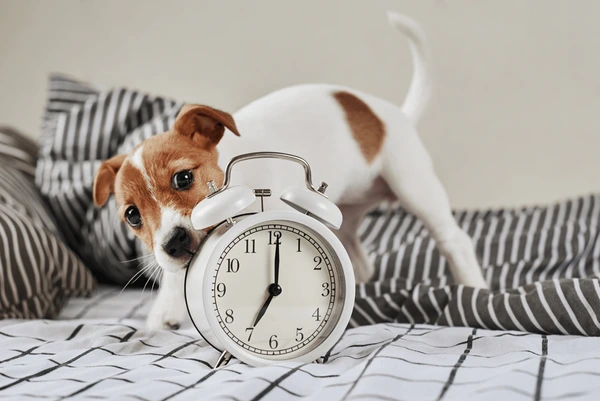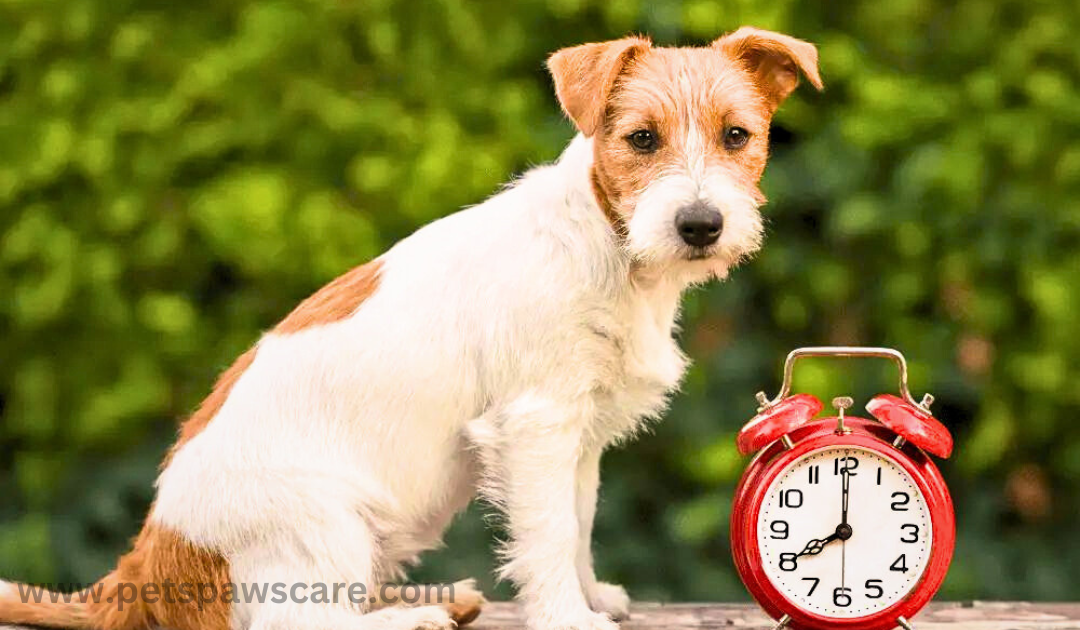How Long is a Few Minutes in Dog Time: Unveiling the Canine Clock
In human timekeeping, a basic few minutes might seem insignificant, but for a dog, these moments could stretch to feel like an expansive 15 or 20 minutes in dog time. This perceived extension is attributed to their acute senses and a metabolic rate that surpasses ours significantly. Grasping how dogs experience minutes in dog time can profoundly deepen the connection between pets and their owners. It’s a question that tickles the curiosity of many pet lovers: Just how do our canine companions perceive the passing seconds and minutes in dog time?
While many of us are familiar with saying that one dog year is equivalent to seven human years, the concept doesn’t neatly translate to shorter periods like minutes in dog time. Contrary to popular myths, scientific research indicates that dogs possess a sense of time, but it neither speeds up nor slows down dramatically, as some legends would have us believe. Instead, dogs seem to measure their days more by the routines established by their humans and the environmental cues around them.
This exploration into the “dog time” concept not only dispels common misconceptions but also provides practical insights for dog owners. Understanding how dogs perceive minutes in dog time can help us align our schedules with their needs, fostering a deeper bond and more harmonious companionship.
The Concept of Minutes in Dog Time
Have you ever wondered how time unfolds for your dog? Unlike humans, dogs experience time in a unique way. For them, a day is less about the ticking of a clock and more about the familiar rhythms and routines that shape their world. Exploring the intriguing concept of ‘dog time’ unveils a fascinating aspect of our pets’ perception, offering a key to understanding their inner temporal landscape.

Canine Perception of Time
While humans are tethered to the ticking of clocks, dogs experience time through a rich sensory tapestry woven from their daily interactions and environmental cues. Unlike us, dogs don’t divide time into abstract segments like hours or minutes. Instead, their days are punctuated by tangible events—walks, meals, and play sessions-that serve as markers in their unique temporal landscape.
Daily Routines: These are not just the cornerstone of a dog’s internal clock, but also the key to their well-being. Consistency in daily activities helps dogs anticipate upcoming events, creating a rhythm to their day and providing them with a sense of security.
Scents: As odours dissipate over time, they provide dogs with a unique olfactory method to gauge the passage of time. A scent growing fainter can signal the passing of hours or even days.
Lighting Changes: Variations in light, from the bright rays of dawn to the dim glow of dusk, serve as visual cues that help dogs differentiate between different times of the day.
Factors Affecting Dog Time Perception
A dog’s perception of time is not static but is influenced by various factors that can either compress or extend their sense of the passing moments.
| Factor | Influence on Time Perception |
|---|---|
| Breed and Age | Some breeds perceive time differently, and perception changes as dogs age |
| Attention and Memory | Dogs with better memory might experience time as moving slower |
| Emotions | Excitement speeds up time perception, while anxiety slows it down |
| Owner’s Presence | Time flies when an owner is around, drags when they’re gone |
An appreciation for ‘dog time’ deepens your understanding of your pet’s internal world and enhances the bond you share. Recognizing and respecting these patterns ensures that every minute spent with your four-legged friend is as fulfilling as possible.
Also Read: Why Is My Dog Head Hot?
Understanding Dog Aging and Time Perception
Have you ever wondered what time feels like for our four-legged companions? Unlike humans, dogs experience the passage of life quite differently. In this exploration, we delve into the intricate workings of dog ageing and time perception, giving you a glimpse into the unique tick tock of the canine clock.
Comparing Human and Dog Aging Processes
It’s a common belief that one human year equates to seven dog years, but this simplification needs to capture the whole story. In reality, dogs mature much more rapidly than humans in their early years, and this rate of ageing varies significantly across different breeds and sizes. For instance, larger breeds often age quicker than their smaller counterparts.
Here’s a quick comparison to put it into perspective:
| Human Years | Dog Years (Small Breed) | Dog Years (Large Breed) |
|---|---|---|
| 1 | 15 | 12 |
| 5 | 36 | 42 |
| 10 | 56 | 60 |
Understanding these differences is crucial for spotting age-related changes and adjusting care needs accordingly. Regular health checkups are vital, and signs like the onset of grey fur are poignant reminders of the passage of time in our dogs’ lives.
How Dogs Perceive Time Differently?
Dogs don’t keep an eye on the clock. Instead, their perception of time is tightly linked to their daily routines and internal body clocks. Meal times and walks are anticipated through cues such as the morning sunlight or the familiar sound of an alarm clock. Disruptions in these routines can lead to confusion and stress.
Smell as a Timekeeper: With their powerful noses, dogs can detect how long you’ve been gone by the strength of your scent left behind. A fading scent signals a more extended absence.
Emotional Clocks: Studies suggest dogs definitely sense the passing of time, growing increasingly excited as the moment of your return draws near. The joyous wagging of their tails upon your return isn’t just happiness—it’s a marker of time, showing they missed you and knew you would return.
Also Read: Dog Allergies

Quantifying Dog Time
Curious about how dogs understand time? The idea of “Quantifying Dog Time” lets us see that for dogs, time isn’t about seconds or minutes. Instead, dog time is about smells, routines, and the cycles of the sun. In dog time, there is a unique rhythm that’s very different from how humans keep track of time. Join us as we explore how our pets experience their days and nights in their own version of dog time.
The Science Behind Dog Time Perception
Grasping how dogs perceive time requires us to step away from our human views of hours and minutes and, instead, tune into the biological rhythms that dictate canine life. Dogs don’t watch clocks; they read the day’s script through the recurring patterns and subtle changes in their surroundings.
Routine Activities as Time Markers: Regular events like meals and walks are pivotal in setting a dog’s internal timeline.
Natural Light Cycles: The shift between daylight and darkness helps regulate their biological clocks.
Scent Evolution: Dogs can detect changes in scent over time, which helps them gauge the duration of events or absences.
Measuring Time Perception in Dogs
Scientists employ creative and insightful methods to unravel how dogs perceive time, focusing on canine behaviours and learning responses. One common approach involves observing how dogs react to varying lengths of time separated from their owners.
| Experiment | Duration | Dog’s Reaction |
|---|---|---|
| Short Absence | 2 minutes | Mild interest |
| Long Absence | 30 minutes | Excited greeting |
These experiments reveal that dogs do indeed have a nuanced understanding of time. A more extended absence typically elicits a more enthusiastic greeting, suggesting that dogs perceive these intervals as extended periods. While these findings are intriguing, they represent the beginning of understanding the depth of time perception in dogs.
Exploring Factors Influencing Dog Time Perception
Do dogs experience about dog time the way humans do? Delving into the factors influencing dog time perception helps us appreciate how what feels like mere minutes to us can be much longer from a dog’s perspective. Various elements can significantly alter how dogs perceive those ticking seconds:
Routine Disruptions: Changes in daily schedules can disorient dogs, making time seem to stretch or shrink.
Emotional States: Just like humans, a dog’s emotional state can warp their sense of time, with anxiety or excitement playing significant roles.
Environmental Changes: From changing household scents to rearranging furniture, subtle shifts in a dog’s environment can dramatically impact their time awareness.
By understanding these factors, we can better synchronize our lives with our canine companions, ensuring they feel secure and valued in the shared rhythm of our everyday lives.

Impact of Breed and Size on Time Perception
Time doesn’t tick uniformly for all dogs—breed and size play significant roles in shaping how they perceive the passage of time.
Large Breeds: Often perceived as more laid back, large dogs may experience minutes in dog time more slowly. Their relaxed nature might make a lazy afternoon stretch out seemingly indefinitely, with minutes in dog time feeling much longer.
Small Breeds: In contrast, small breeds, buzzing with energy and constantly on the move, often appear to experience minutes in dog time at a faster pace. Every minute in dog time for them is brimming with activity and excitement, making their days feel more action-packed.
Also Read: Why Do Dog Scratch The Carpet and floor?
Effect of Environmental Stimuli on Dog Time
The environment surrounding a dog can dramatically speed up or slow their perception of time. In an engaging setting, like a busy park filled with intriguing smells and potential playmates, minutes in dog time can seem to fly. Conversely, in a peaceful nap spot where little changes, minutes in dog time can drag endlessly. The way dogs experience minutes in dog time depends greatly on their surroundings. When they’re active and entertained, minutes in dog time pass quickly, but in a calm and unchanging environment, those minutes in dog time feel much longer. Understanding how the environment affects minutes in dog time helps us create more fulfilling experiences for our pets.
| Stimulus | Interaction | Time Perception | Interest Level |
|---|---|---|---|
| Toy | Fast Time | Engaging | High |
| Alone Time | Slow Time | Quiet | Low |
The Human Perspective
From a human viewpoint, time is measured precisely by clocks and calendars, and we organize our lives down to the minute. However, stepping into the paws of our furry friends reveals a vastly different perspective. Exploring dog time enriches our understanding and deepens the connection we share with them. Understanding dog time enhances our mutual experiences and strengthens our bonds by appreciating the unique way dogs perceive time.
Aligning Human and Dog Time Perception
Grasping how dogs perceive time is more than an academic exercise—it’s a key to better communication and a stronger relationship with our canine companions. Unlike humans, who manage their days with digital clocks and apps, dogs rely on the natural rhythm of daily routines to frame their understanding of time:
Feeding Schedules: Dogs expect meals consistently, using these moments as major time anchors in their day.
Walks: Previous outings set expectations for their next adventure, with anticipation building around usual walk times.
Sleep Patterns: Similar to humans, dogs have sleep cycles that adapt to the household’s rhythm, influencing how they perceive the passage of each day.
Even a slight delay in their expected routine can feel significantly longer to a dog, as they measure time not by minutes and hours but through the predictable patterns of their daily lives.

Interactions Based on Time Understanding
Interactions with our dogs are often defined by a mutual yet unspoken understanding of time. Unlike humans, dogs don’t quantify their separation from us in hours or minutes. Instead, their perception is guided by environmental cues:
Light Changes in the Home: These shifts signal the time of day to a dog, much like a clock does for us.
Household Noises: Sounds like the clatter of dishes or the hum of a vacuum cleaner indicate routine activities that help them gauge time.
Scents: The fading or intensifying of smells can suggest how much time has passed.
For instance, what feels like a brief errand to us might seem endless to a dog left waiting. Conversely, after a long day at work, our return might simply mean “playtime” to our dogs, with no concept of the past hours.
We can foster more harmonious interactions by aligning our understanding of time with our dogs’ perceptions. Recognizing their sensitivity to routine helps us create a more balanced and reassuring environment for them.
Future Research and Considerations
The study of how dogs perceive time is a burgeoning field, rich with potential discoveries. Researchers continuously seek to delve deeper into the mysteries of canine temporality, posing questions about how minutes in dog time differ from our own. Understanding minutes in dog time promises intriguing insights into their daily lives. As scientists explore the complexities of minutes in dog time, they uncover how dogs experience their world. These studies aim to reveal how minutes in dog time affect their behavior and interactions with us.
Advancements in Understanding Dog Time
Our quest to understand how dogs interpret time is evolving. Each new study provides valuable pieces to a dog’s internal clock puzzle. Recent research suggests that minutes in dog time are perceived in a complex and nuanced way, yet much remains to be uncovered.
Scientists are developing new theories and models to better understand how dogs process events and track minutes in dog time. With the aid of emerging technologies, we anticipate significant advancements in our comprehension of the canine mind. These insights into minutes in dog time will enhance how we train and care for our dogs and how we relate to them emotionally and cognitively. Understanding minutes in dog time helps us connect better with our furry friends.
Unexplored Aspects of Canine Temporality
Despite significant progress, many aspects of canine temporality remain unexplored. Future research will address questions such as:
Impact of Breed and Size: Do larger breeds like Great Danes perceive time differently than smaller breeds like Chihuahuas?
Role of Emotions: How do emotions such as joy, fear, or excitement impact a dog’s time perception?
Health and Aging: How does a dog’s perception of time change with age or health issues?
Evolving Perceptions: Can training and experience teach dogs to understand time more like humans?
These areas offer fertile ground for future studies, potentially reshaping our understanding of “a few minutes” from a canine perspective.
Conclusion
Understanding time from a dog’s perspective helps us connect better with them and see how they experience the world. Knowing that minutes in dog time can feel very different from our minutes helps us understand their needs and adjust to their sense of time. Enjoy every moment with your dog; each minute is special because minutes in dog time are cherished differently. Embrace every moment because in dog time, every minute you spend together is precious. Remember, minutes in dog time are a unique and special part of your bond.

Hey, Jack here. I’m hooked on your website’s content – it’s informative, engaging, and always up-to-date. Thanks for setting the bar high!